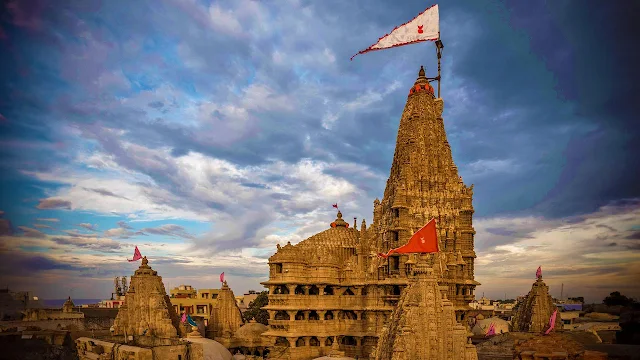Dwarkadhish Temple, Dwarka, Gujarat: A Comprehensive Guide
The Dwarkadhish Temple, also known as Jagat Mandir, stands as a prominent Hindu pilgrimage site in Dwarka, Gujarat. Dedicated to Lord Krishna, this revered temple draws devotees from across the globe. Here's a guide to its timings, history, festivals, and darshan:
Temple Timings:
- General Darshan Hours: The temple is typically open for devotees from 7:00 AM to 12:30 PM and 5:00 PM to 9:00 PM daily.
- Specific Aarti and Puja Timings:
- Mangala Aarti: Around 6:30 AM - 7:00 AM
- Shringar Darshan: Various slots in the morning, typically around 9:00 AM - 10:15 AM.
- Rajbhog: Around 12:00 PM - 12:30 PM (Darshan may be closed during Bhog offerings)
- Uthappan Darshan: Around 5:00 PM - 5:30 PM
- Sandhya Aarti: Around 7:30 PM - 7:45 PM
- Shayan Aarti: Around 8:30 PM - 9:00 PM
- Note: Darshan is generally closed during Bhog (food offerings to the deity) and Anosar (rest period for the deity). It is advisable to check the temple's official website or local listings for the most current and detailed schedule, as timings for specific rituals can vary.
History:
The Dwarkadhish Temple boasts a rich and ancient history, steeped in legend and faith:
- Ancient Origins: It is widely believed that the original temple was established over 2500 years ago by Vajranabh, the great-grandson of Lord Krishna, on the site of Krishna's legendary capital. Archaeological findings also suggest an original temple structure dating back to 200 BCE.
- Destruction and Reconstruction: The temple has faced periods of destruction and subsequent rebuilding. The original structure is said to have been destroyed by Mahmud Begada in 1472. The present imposing five-storied structure, built of limestone and sand, primarily reflects the 16th-century Chalukya style of architecture and is supported by 72 intricately carved pillars.
- Adi Shankaracharya's Visit: The revered 8th-century Hindu theologian and philosopher, Adi Shankaracharya, visited the shrine, further establishing its significance as a major pilgrimage center. Dwarka is one of the four Char Dham sites.
- Legends: According to legend, Lord Krishna reclaimed 12 yojanas (approximately 96 square kilometers) of land from the sea to build the city of Dwarka. The city's name itself means "gateway to heaven."
Festivals:
The Dwarkadhish Temple is a hub of vibrant celebrations throughout the year. Key festivals include:
- Janmashtami: This is the most important festival, celebrating the birth of Lord Krishna. The temple is magnificently decorated, and celebrations, including bhajans, kirtans, and special pujas, continue through midnight, the time of Krishna's birth.
- Holi: The festival of colors is celebrated with great enthusiasm.
- Diwali: The festival of lights sees the temple illuminated beautifully.
- Annakut Utsav: Celebrated after Diwali, a mountain of food is offered to the deity.
- Tulsi Vivah: The ceremonial marriage of Lord Krishna to the Tulsi plant.
- Rath Yatra: A chariot festival.
- Other Festivals: Numerous other festivals like Basant Panchami, Ram Navami, and Akshaya Tritiya are also celebrated with fervor.
- Dhwaja Ceremony (Flag Changing): A unique and significant daily ritual is the changing of the temple's flag (Dhwaja). The massive 52-yard flag, bearing images of the sun and moon, is changed multiple times a day (sources vary between three to five times). This is a grand ceremony that devotees can witness.
Darshan Guide:
- Entrances: The temple has two main entrances:
- Swarga Dwar (Gate to Heaven): This is the southern entrance, typically used for entry, and leads towards the Gomti River.
- Moksha Dwar (Gate to Liberation): This is the northern entrance, often used as the exit, and opens towards the main market.
- Dress Code: While there isn't a strict mandatory dress code, devotees are encouraged to dress modestly in traditional Indian attire. It is advisable for women to wear sarees or salwar kameez and for men to wear dhoti or kurta-pajama. Shorts, mini-skirts, and overly casual attire should be avoided.
- Prohibited Items: Photography and videography are strictly prohibited inside the temple premises. Mobile phones and other electronic gadgets must be switched off or deposited at the designated counters.
- Guides: Official and unofficial guides are often available near the temple. While they can provide detailed explanations of the temple's history and significance, their services are not mandatory for darshan.
- Offerings: Devotees can make offerings of flowers, sweets, and other traditional items.
- Security: Be prepared for security checks at the entrance.
- Facilities: Facilities for storing footwear and belongings are usually available.
- Nearby Attractions: While in Dwarka, you can also visit the Rukmini Devi Temple, Gomti Ghat, Nageshwar Jyotirlinga Temple, and Bet Dwarka.
Official Website:
For the most accurate and updated information, you can visit the official website of the Dwarkadhish Temple:
A visit to the Dwarkadhish Temple offers a deeply spiritual and culturally enriching experience, connecting visitors to centuries of faith and devotion.




Comments
Post a Comment